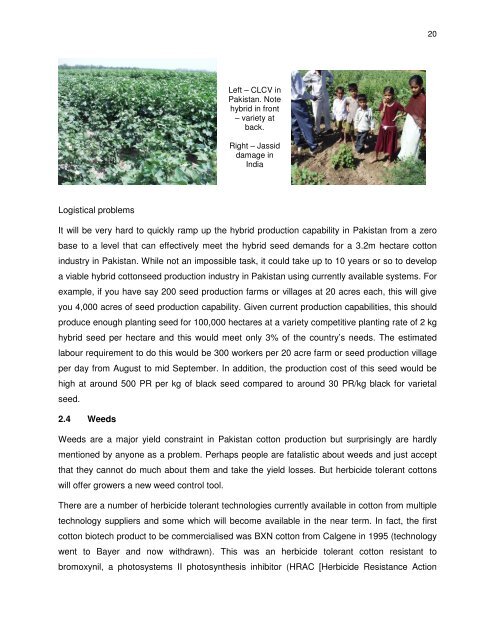ChangingCottonLandscapeNeilForrester
ChangingCottonLandscapeNeilForrester
ChangingCottonLandscapeNeilForrester
You also want an ePaper? Increase the reach of your titles
YUMPU automatically turns print PDFs into web optimized ePapers that Google loves.
Logistical problems<br />
It will be very hard to quickly ramp up the hybrid production capability in Pakistan from a zero<br />
base to a level that can effectively meet the hybrid seed demands for a 3.2m hectare cotton<br />
industry in Pakistan. While not an impossible task, it could take up to 10 years or so to develop<br />
a viable hybrid cottonseed production industry in Pakistan using currently available systems. For<br />
example, if you have say 200 seed production farms or villages at 20 acres each, this will give<br />
you 4,000 acres of seed production capability. Given current production capabilities, this should<br />
produce enough planting seed for 100,000 hectares at a variety competitive planting rate of 2 kg<br />
hybrid seed per hectare and this would meet only 3% of the country’s needs. The estimated<br />
labour requirement to do this would be 300 workers per 20 acre farm or seed production village<br />
per day from August to mid September. In addition, the production cost of this seed would be<br />
high at around 500 PR per kg of black seed compared to around 30 PR/kg black for varietal<br />
seed.<br />
2.4 Weeds<br />
Weeds are a major yield constraint in Pakistan cotton production but surprisingly are hardly<br />
mentioned by anyone as a problem. Perhaps people are fatalistic about weeds and just accept<br />
that they cannot do much about them and take the yield losses. But herbicide tolerant cottons<br />
will offer growers a new weed control tool.<br />
Left – CLCV in<br />
Pakistan. Note<br />
hybrid in front<br />
– variety at<br />
back.<br />
Right – Jassid<br />
damage in<br />
India<br />
There are a number of herbicide tolerant technologies currently available in cotton from multiple<br />
technology suppliers and some which will become available in the near term. In fact, the first<br />
cotton biotech product to be commercialised was BXN cotton from Calgene in 1995 (technology<br />
went to Bayer and now withdrawn). This was an herbicide tolerant cotton resistant to<br />
bromoxynil, a photosystems II photosynthesis inhibitor (HRAC [Herbicide Resistance Action<br />
20


